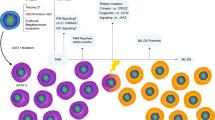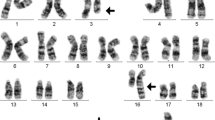Abstract
The present study aimed to identify optimal treatment intensity in children with mosaic Down syndrome (DS) and acute megakaryoblastic leukemia (AMKL). A retrospective review of AMKL patients was undertaken to identify mosaic DS children. Between November 1992 and November 2007, seven children were diagnosed as mosaic DS and AMKL. The median age at diagnosis was 29 months (range 4–34 months). Three patients had a past history of transient abnormal myelopoiesis. UPN1–4 were treated with intermediate-dose cytarabine and UPN4 received additional one course of high-dose cytarabine. All of these patients were remained in first CR. UPN5–7 were treated with high-dose cytarabine according to the AML99 protocol. UPN5 with GATA1 mutation suffered from acute pneumonia and pancreatitis and discontinued chemotherapy. UPN7 relapsed after cessation of chemotherapy and was rescued with allo-PBSCT. The cumulative doses of cytarabine were 3.5–10.65 g/m2 in the UPN1–4 and 40.4–78.4 g/m2 in the UPN5–7. The 8-year overall survival was 100% and the 8-year event-free survival 85.7%, respectively. Our retrospective study reveals that patients with mosaic DS and AMKL have a good prognosis. Reduction in intensity may work in patients with mosaic DS as well as with AML-DS.

Similar content being viewed by others
References
Devlin L, Morrison PJ. Accuracy of the clinical diagnosis of Down syndrome. Ulster Med J. 2004;73:4–12.
Kojima S, Sako M, Kato K, et al. An effective chemotherapeutic regimen for acute myeloid leukaemia and myelodysplastic syndrome in children with Down’s syndrome. Leukemia. 2000;14:786–91.
Kudo K, Kojima S, Tabuchi K, et al. Prospective study of a pirarubicin, intermediate-dose cytarabine, and etoposide regimen in children with Down syndrome and acute myeloid leukaemia: the Japanese Childhood AML Cooperative Study Group. J Clin Oncol. 2007;25:5442–7.
O’Brien MM, Taub JW, Chang MN, et al. Cardiomyopathy in children with Down syndrome treated for acute myeloid leukemia: a report from the Children’s Oncology Group Study POG 9421. J Clin Oncol. 2008;26:414–20.
Gamis AS, Woods WG, Alonzo TA, et al. Increased age at diagnosis has a significantly negative effect on outcome in children with Down syndrome and acute myeloid leukemia: a report from the Children’s Cancer Group Study 2891. J Clin Oncol. 2003;21:3415–22.
Abildgaard L, Ellebaek E, Gustafsson G, et al. Optimal treatment intensity in children with Down syndrome and myeloid leukaemia: data from 56 children treated on NOPHO-AML protocols and a review of the literature. Ann Hematol. 2006;85(5):275–80.
Creutzig U, Reinhardt D, Diekamp S, et al. AML patients with Down syndrome have a high cure rate with AML-BFM therapy with reduced dose intensity. Leukemia. 2005;19:1355–60.
Rao A, Hills RK, Stiller C, et al. Treatment for myeloid leukaemia of Down syndrome: population-based experience in the UK and results from the Medical Research Council AML 10 and AML 12 trials. Br J Haematol. 2006;132:576–83.
Simon JH, Tebbi CK, Freeman AI, et al. Acute megakaryoblastic leukaemia associated with mosaic Down’s syndrome. Cancer. 1987;60:2515–20.
Tsukimoto I, Tawa A, Horibe K, et al. Risk-stratified therapy and the intensive use of cytarabine improves the outcome in childhood acute myeloid leukemia: the AML99 trial from the Japanese Childhood AML Cooperative Study Group. J Clin Oncol. 2009;27:4007–13.
Kaplan EL, Meier P. Nonparametric estimation for incomplete observations. J Am Stat Assoc. 1958;53:457–81.
Iizuka A, Nagao T. A case of acute megakaryoblastic leukaemia associated with mosaic Down’s syndrome. Jpn J Pediatr Hematol. 1988;92:1598–603.
Kurosaki M, Sugita K, Ohneda S, et al. A case of megakaryoblastic leukaemia after recovering from transient abnormal myelopoiesis with mosaic Down’s syndrome. Jpn J Pediatr Hematol. 1990;4:114–9.
Doyle JJ, Thorner P, Poon A, et al. Transient leukaemia followed by megakaryoblastic leukaemia in a child with mosaic Down syndrome. Leukemia Lymphoma. 1995;17:345–50.
Palmer CG, Blouin JL, Bull MJ, et al. Cytogenetic and molecular analysis of a ring (21) in a patient with partial trisomy 21 and megakaryocytic leukaemia. Am J Med Genet. 1995;57:527–36.
Punnett HH, Dampier C. Trisomy 11 limited to trisomy 21 cells in a mosaic Down syndrome child with acute myeloid leukaemia. Med Pediatr Oncol. 2003;41:69–70.
Hasle H, Abrahamsson J, Arola M, et al. Myeloid leukemia in children 4 years or older with Down syndrome often lacks GATA1 mutation and cytogenetics and risk of relapse are more akin to sporadic AML. Leukemia. 2008;22:1428–30.
Sandoval C, Pine SR, Guo Q, et al. Tetrasomy 21 transient leukaemia with a GATA1 mutation in a phenotypically normal trisomy 21 mosaic infant: case report and review of the literature. Pediatr Blood Cancer. 2005;44:85–91.
Author information
Authors and Affiliations
Corresponding author
Additional information
K. Kudo, A. Morimoto, A. Tawa and I. Tsukimoto are members of The Japanese Childhood AML Cooperative Study Group, Japan.
About this article
Cite this article
Kudo, K., Hama, A., Kojima, S. et al. Mosaic Down syndrome-associated acute myeloid leukemia does not require high-dose cytarabine treatment for induction and consolidation therapy. Int J Hematol 91, 630–635 (2010). https://doi.org/10.1007/s12185-010-0549-1
Received:
Revised:
Accepted:
Published:
Issue Date:
DOI: https://doi.org/10.1007/s12185-010-0549-1




